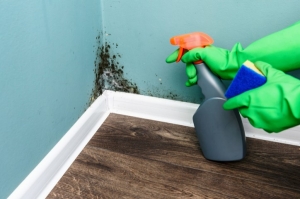Choose Safe Places: Mold
Mold is a moisture problem
Molds are found in virtually every environment and, can be found indoors and outdoors year-round. Mold is a moisture problem. Mold growth is encouraged by warm and humid conditions. Indoors molds can be found where humidity levels are high, such as basements or bathrooms.
The first step to getting rid of mold is to find the moisture causing the mold. Do you see any signs of wetness in your building?
- Wet or water-stained walls, ceilings or floors
- Wet carpet
- Condensation on windows
- Wet soil in crawl space
Can you tell where the water is coming from?
- Leaking roof
- Broken water pipes
- Water getting in a crawl space due to poor drainage around a building
- Air conditioner not being used or not working properly
- Water seeping through basement block walls
Once you have found the moisture, you must take steps to stop it from getting into your building. Without stopping the moisture, the mold will continue to come back.
- Repair any broken pipes or roof leaks promptly
- If leaks are severe, consider turning off water to the building or covering the roof until repairs can be made
- Use fans to circulate air and keep areas dry
- Vent fans in kitchens and bathrooms can help reduce condensation
- Provide good drainage for surface and rain water
- Keep gutters in good condition
- Slope the ground away from the building foundation
- Properly seal basement areas
Dampness around foundations, in basements or within crawlspaces may require extra care. Foundations should have a vapor barrier in place. Foundation or basement walls may need a water-tight paint or sealant. Basements and crawlspaces should have adequate ventilation and/or dehumidification. Making sure rainwater does not flood up against the foundation wall is important. A French drain or sump pump may be needed to remove groundwater. Water near the foundation can move into the inside of a building making it damp as well.
How to clean mold
Mold growth can be removed from hard surfaces with soap and water. Bleach can be an asthma trigger. Using bleach to clean mold is typically not necessary unless a sewage release occurred. In this case, both mold and bacteria can be reduced using a bleach solution as a final disinfecting rinse. If disinfectants or bleach is used, always ventilate the area and exhaust the air to the outdoors. Never mix chlorine bleach with other cleaning solutions or with detergents that contain ammonia because toxic fumes could be produced. Click to learn more about Green Cleaning from the University of Tennessee Agriculture Extension.
When to remove and replace molded materials
If the surface affected by mold is porous such as sheet rock or carpet, it will likely need to be replaced. Molds can thrive on any organic matter, including clothing, leather, paper, ceilings, and walls and floors of buildings with moisture management problems. Painting or caulking over mold will not solve the problem. Click here for more information from the Virginia Coopertative Extension on mold growth in various materials.
Should I test for mold?
Many people think the first step to getting rid of the mold in their building is to conduct a test to identify the mold. However, experts do not recommend testing to identify the type of mold because all types can cause problems, regardless of toxicity. The Tennessee Department of Health does not do mold testing. We do not know of any government agency that will test your building for mold. The Centers for Disease Control and Prevention (CDC) and the Environmental Protection Agency (EPA) do not recommend testing. Proper tests are expensive and there are no standards for acceptable mold levels. Since the effect of mold on people can vary greatly, the presence of mold in a building does not imply a health risk. Whatever type of mold may be present should be cleaned and moisture problems in the building corrected so that the mold does not return.
If the source of excess moisture is not apparent, testing for the presence of excess moisture can provide valuable information to assist in identifying the source of a mold problem.
Moisture meters and digital humidity monitors are relatively inexpensive and available at many home improvement stores. Both can be helpful. A moisture meter can tell you how much water is inside of building materials. For example, a moisture meter can tell if drywall or flooring is damp inside. A humidity monitor can tell you how much water is in the air. A humidity monitor can show if the air in the room is too damp. Maintain indoor humidity ideally between 30-50 percent.
Always hire a licensed contractor for repairs. Check with the Tennessee Department of Commerce and Insurance to verify a contractor license at http://verify.tn.gov/.
You can find additional information about indoor air quality and mold online at www.epa.gov/mold or www.cdc.gov/mold.
Additional resources
U.S. Environmental Protection Agency
Mold Remediation in Schools and Commercial Buildings
www.epa.gov/mold/printable-version-mold-remediation-schools-and-commercial-buildings
Indoor Air Quality Tools for Schools kit
http://www.epa.gov/iaq/schools
A Brief Guide to Mold, Moisture, and Your Home
www.epa.gov/mold/printable-version-brief-guide-mold-moisture-and-your-home
Una Breve Guía para el Moho, la Humedad y su Hogar
espanol.epa.gov/cai/publicaciones-sobre-calidad-del-aire-interior#tab-2
Pediatric Environmental Health Specialty Units (PEHSU)
Mold
https://www.pehsu.net/health_professionals_families/health_topics/mold/

